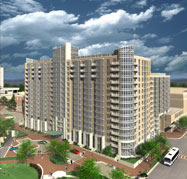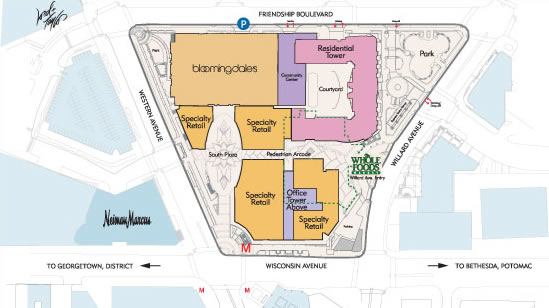
Jenna Marcolina |
Construction Management Wisconsin Place Residential Chevy Chase, MD |
| Home | |
| Student Bio | |
| Building Statistics | |
| Thesis Abstract | |
| Tech Assignments | |
| Thesis Research | |
| Thesis Proposal | |
| Presentation | |
| Final Report | |
| Reflection | |
eStudio
|
|
Building Statistics
General Building Data
Building name: Wisconsin Place Residential
Location and site: Chevy Chase, MD
Building Occupant Name: Wisconsin Place Residential, LLC
Occupancy or function types (type of building): Residential apartment tower
Size (total square feet): 497,000 SF
Number of stories above grade: 15
Primary project team:
Construction Manager: Turner Construction Company
Owner: Wisconsin Place Residential, LLC, c/o Archstone-Smith Trust
Architect: SK&I Architectural Design Group, LLC
Interior Designer: Handel Architects, LLP
Landscape Architect: Carol R. Johnson Associates
Structural Engineer: Smislova, Kehnemui & Associates, PA
Mechanical and Electrical Engineers: GHT Limited
Civil Engineer: Loeiderman Soltesz Associates
Specifications Consultant: Johnson and Johnson Consultants, LLC
Dates of construction: June 2007 – February 2009
Building Cost: $90 million
Project delivery method: GMP
Architecture
Architecture: Wisconsin Place is a 1.1 million square foot development on an 8 acre site situated on Wisconsin Avenue in the affluent neighborhood of Chevy Chase, MD. This mixed use development is comprised of high end retail and restaurant space, office and residential space, an underground parking structure, and a community center. It is described on its promotional website as the “epicenter of dining, shopping, living and working in the District and Montgomery County (www.wisonsinplace.com).”
My thesis will focus only on the U-shaped residential tower that is to contain 432 rental apartments, including studio, one-, and two-bedroom units, with an exclusive selection of penthouses.
Wisconsin Place Residential is a post-tensioned concrete structure. Many building materials constitute the façade, including glass, glazing, aluminum-faced composite wall panels, brick, precast and cast stone, aluminum window system, aluminum metal panel system, and pre-finished steel channels.
Major national codes:
IBC 2003
International Mechanical, Plumbing, Fuel Gas, Energy Conservation Code
National Electric Code 1990
International Plumbing Coed 1995 with 1996 Supplements
NFPA-13, 14, 20, 24, 54
BOCA 1996
D.C.M.R.
Zoning: Residential
Historical requirements: None
Building envelope: The brick exterior wall system is comprised of ½ inch gypsum board followed by a 6 mil polyethelene vapor barrier. R13 batt insulation lines the space between the gypsum and 4 inch light gauge steel studs topped with ½ inch sheathing and asphalt felt. Galvanized brick ties fasten the brick to the façade, and continuous flashing extends 1/8 inch beyond the face of the brick for proper drainage. Cell vents are placed at 24 inches on center horizontal above finish grade where flashing does not cover the brick.
The cast stone exterior wall system is very similar to the brick wall system. Galvanized brick ties hold cast stone in place while ½ inch mortar joints are left between each row of stone. Weep holes are located at 24 inches on center to allow water to escape.
The roof system consists of .215 mil hot applied rubberized asphalt with reinforcing. Base flashing and flashing membrane line the roof as well as rigid R15 insulation, filter fabric, and aggregate ballast with leveler seats.
Primary Engineering Systems
Construction
Archstone-Smith Trust, a prominent developer in the Washington, DC area, hired Turner as the general contractor for the 15 story, 485,000 square foot Wisconsin Place Residential project that began construction in June 2007. WPR is only part of a 1.1 million square foot mixed use development known as “Wisconsin Place” that includes high end retail, restaurant, and office space. Wisconsin Place presents a very unique situation. Due to the magnitude of the project, it has been divided into four main parts and the work was awarded to four separate general contractors. They are assigned as follows:
- Turner- parking garage
- Turner- residential tower
- Centex- office tower
- TBD- retail
Three developers are also involved in the massive project: New England Development, Archstone-Smith Trust, and Boston Properties, Inc. Each firm has a specialized interest in Wisconsin Place, and three grand visions will be realized in its construction. It will be interesting to see how all of these players interact on a congested site in the middle of the city.
Wisconsin Place Residential sits directly on top of a four level below grade parking garage that is managed by a separate Turner team. Construction of the parking garage is still in progress, which poses daily challenges to both Turner teams working in such close quarters. Weekly coordination meetings alleviate site congestion problems.
Electrical System
Wisconsin Place receives a main feed of 3 phase 2,000 Amp service from the existing switchboard in the parking garage electrical room. Each apartment has its own 120/208 Volt panel along with an individual metering unit. This makes it possible to bill each apartment separately for electricity and saves the owner a lot of work. A 350 kW standby emergency generator is located on the roof. Small electric rooms are located on each floor of the apartment building, while a larger main electric room is located on the penthouse level.
Lighting System
Most of the lighting fixtures are included in Turner’s contract; however a select few fixtures in public areas are being furnished by the owner. The apartment unit lighting fixtures use primarily inside frosted incandescent lamps rated for 130 Volts. The kitchen features recessed and under-cabinet lighting as well as track and pendant lights. Exterior fixtures utilize mercury vapor, phosphor-coated metal halide, and high pressure sodium lamps Aluminum surfaces exposed to weathering are coated with a duronodic or polyester powder paint finish for corrosion resistance.
Mechanical System
All of the major mechanical equipment is located on the penthouse level. Each apartment unit contains a small AHU to regulate temperature and air flow. This makes each apartment independent of the next and optimizes comfort control for residents. The mechanical system features automatic temperature controls and a submetering system.
The constant air volume system includes open and closed loop filtration to service WPR. The penthouse contains 5 rooftop units made up of a compressor, supply air, heating and cooling coil that operate on 480 Volt 3 phase power. Two cooling towers with a 48 gpm pump also inhabit the penthouse. They operate at a 1450 gpm flow rate between temperatures of 85 to 95 degrees Fahrenheit. A sand filtration and UV disinfection system help purify the water that passes through the cooling towers, and nitrites are added to further cleanse the system.
Structural System
Since WPR sits atop a parking garage, no foundation system was required. The parking garage is supported by spread footings and foundation walls and was designed to carry the full load of the residential tower above.
The building structure consists of concrete columns and post-tensioned concrete slabs. The 7-wire stress-relieved strands are unbonded and spaced at no more than 5 feet apart. A minimum of 2 tendons in each direction is required directly over columns.
A pump is used to place the massive amounts of concrete that form the building structure, and the slabs are broken into 3-5 sections to make the pours more efficient. The 7 ½ inch thick slabs use 5,000 psi concrete.
Additional Engineering and Engineering Support Systems
Fire Protection
A hydronic fire protection system, consisting of wet and dry standpipes, is to be installed throughout the building. Sprinkler heads are located below the ductwork and above light fixtures in finished spaces. A supervised shut-off valve, flow detector, drain line, and inspector’s test connection are to be provided at each connection between standpipes and sprinkler systems. Where water pressure exceeds 100 psig, automatic pressure restricting fire hose valves are to be provided.
Transportation
Five electric traction passenger elevators are located in the main lobby of Wisconsin Place Residential. Otis is providing the elevators and will ensure they are compliant with all local and national safety codes. The elevator machine room is located in the penthouse.
A 24-inch diameter refuse chute travels the entire height of the building to discreetly dispose of waste. Heat and smoke detectors as well as sprinkler heads are to be installed within the trash chute, and the 16 gage aluminum steel chute is to be sprayed with sound dampening material.
Telecommunications
The fire system supplier will layout controls for voice communications and fire phones associated with the annunciator and control panel. The electrician is required to provide a multimedia panel for each apartment unit, containing a telephone module, CATV splitter, and a one duplex 2 phase, 3 Watt, 20 Amp, 125 Volt TVSS receptacle.
Masonry
Many non-load-bearing materials constitute the façade of Wisconsin Place, including glass, glazing, aluminum-faced composite wall panels, brick, precast and cast stone, aluminum window system, aluminum metal panel system, and pre-finished steel channels. This requires meticulous coordination to ensure that all materials fit together and fasten to the structure properly. Attention must be paid to flashing and waterproofing details so that the building is protected from the elements. A major concern for Turner is getting all of the façade materials to the site in a timely manner.

